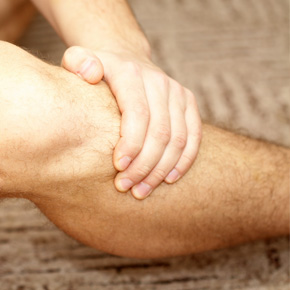Osteopathy can help treat a wide variety of sports injuries from ankle sprains to shin splints. Our osteopaths can also tailor an exercise rehab program to strengthen problem areas to prevent the same sports injuries reoccurring.
 Shin Splints
Shin Splints
What are shin splints?
Pain in the front of the lower legs is often described as shin splints. The jury is still out on the exact mechanism of the injury; however it would seem that shin splints result from inflammation to, or injury of, the tendon (posterior peroneal tendon) and adjacent tissues in the front of the outer leg.
Shin splints are a type of “repetitive strain injury” or “overuse injury” and they tend to be seen more commonly in sports injuries from runners or aggressive walkers.
What are shin splints’ symptoms?
The characteristic pain from shin splints is in the front of the lower leg and it is typically located on the edge of the mid region of the tibia/shinbone. An area of discomfort which can be exquisitely tender when pressed is frequently present. The length of this tender area can often be between 10-15cm.
The onset of shin splint pain is often felt during the early portion of the workout, and then lessens, only to reappear near the end of the training session. Shin splint pain is often described by the athlete as “dull at first”, however, with continuing repetitive trauma, the pain can become so extreme that it can causes the athlete to stop workouts altogether.
What causes shin splints?
One of the primary culprits causing shin splints is a sudden increase in distance or intensity of a workout schedule. We often see this condition in athletes starting pre-season training or in January when trying to run off the Christmas belly! This increase in muscle work may result in inflammation of the lower leg muscles, i.e. those muscles used in lifting the foot (the motion during which the foot flexes toward the tibia).
Some people suffer with excessive pronation (movement of the foot excessively in to the arch when load bearing) of the foot and if present this may bring on, aggravate or prevent early healing of the condition.
A tight Achilles tendon or weak ankle muscles are also often implicated in the development of shin splints.
Treatment
Given that no athlete I’ve ever met suffering this type of sports injury wants to stop altogether it is fortunate that a multifaceted approach of “relative rest” works well and can restore a pain-free level of activity and a return to training.
The “relative rest” approach includes a change in the workout, ice, rest, anti-inflammation medications, stretching exercises, possible change in footwear, and gradual increase in running activities.
Shin Splints respond very well to:
- Icing
- Running on even surfaces that are soft i.e. grass instead of concrete or bitumen.
- Identifying the underlying biomechanical cause (i.e. over-pronation of sub talar joint causing an over stress on lower leg muscles).
- To detect and accurately assess excessive pronation we take a computer Gaitscan to assess the above and potentially prescribe custom made orthotics, depending on results.
- Deep soft tissue to painful splint area (treatment hurts but it is very effective).
- An exercise regime to specifically stretch and strengthen the affected areas.
- Dry Needling/Biomedical Acupuncture given some great results in our experience.